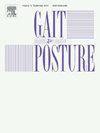Characteristics of standing postural sway without vision depend on the action and duration of stretched ankle muscles
IF 2.2
3区 医学
Q3 NEUROSCIENCES
引用次数: 0
Abstract
Introduction
In the literature, the impact of stretching on postural sway remains unclear. Potential differences across studies involve stretching different muscle groups or stretching muscle groups for different durations, which may alter proprioception abilities and postural sway. We questioned whether flexibility imbalances from short-term stretching of plantar flexors would increase postural sway and proprioception compared to short-term stretching of dorsiflexors and plantar flexors and whether postural sway and proprioception would increase with increased short-term stretch durations.
Methods
We tested whether stretching opposing ankle muscles (opposed—plantar flexors and dorsiflexors) or non-opposing muscles (non-opposed—plantar flexors) for various times (0 s, 15 s, 30 s, 45 s) could influence standing sway and/or proprioception. Young adults received 2–4 bouts of ankle stretches to discomfort before performing static stance (participants stood still with eyes closed for 45 s on a force plate) and ankle proprioception (participants actively matched remembered ankle angles, measured with a goniometer) tasks after 30 s of opposed versus non-opposed stretching (Experiment 1 A) or various stretch times for non-opposed (Experiment 1B) and opposed (Experiment 2).
Results
Results revealed worse performance, thus increased variability of medio-lateral (ML) center of pressure (CoP) and lower ML CoP sample entropy, indicating less automation of sway, after opposed stretching compared to no stretch and/or non-opposed (Experiment 1 A) as well as increased ML CoP displacement and variability of ML CoP and lower ML CoP sample entropy after 45 s of opposed stretches compared to no stretch (Experiment 2). Stretching did not significantly influence proprioception; however, proprioception error negatively correlated with variability of ML CoP and ML CoP displacement.
Discussion
The better ability to actively reproduce ankle positioning associates with a better internal sense of position and encourages an internal focus on movement, known to increase postural sway. Care should be taken with stretched-induced hypermobility in a balance-challenged environment like that with eyes closed.
无视觉的站立姿势摇摆的特征取决于踝关节肌肉拉伸的动作和持续时间
在文献中,伸展对体位摇摆的影响尚不清楚。不同研究之间的潜在差异包括拉伸不同的肌肉群或拉伸肌肉群的持续时间不同,这可能会改变本体感觉能力和姿势摇摆。我们的问题是,与背屈肌和足底屈肌的短期拉伸相比,短期拉伸引起的灵活性失衡是否会增加姿势摆动和本体感觉,以及姿势摆动和本体感觉是否会随着短期拉伸时间的增加而增加。方法我们测试了不同时间(0 s, 15 s, 30 s, 45 s)拉伸对跖肌(对跖屈肌和背屈肌)或非对跖屈肌(非对跖屈肌)是否会影响站立摇摆和/或本体感觉。在进行30 秒的对向和非对向拉伸(实验1 a)或不同的对向拉伸(实验1B)和对向拉伸(实验2)后,年轻人在进行静态站立(参与者闭着眼睛站在原地45 s)和踝关节本体感受(参与者积极匹配记忆中的踝关节角度,用测角仪测量)任务之前接受2 - 4次踝关节拉伸至不适。结果显示,与不拉伸和/或不拉伸相比,反向拉伸后中外侧压力中心(ML -lateral center of pressure, CoP)的变异性增加,ML - CoP样本熵降低,表明摇摆的自动化程度较低(实验1 A);与不拉伸相比,45 s的反向拉伸后ML - CoP位移增加,ML - CoP的变异性增加,ML - CoP样本熵降低(实验2)。拉伸对本体感觉无显著影响;然而,本体感觉误差与ML - CoP和ML - CoP位移变异性呈负相关。更好的主动重现脚踝定位的能力与更好的内部位置感相关,并鼓励内部关注运动,众所周知,这可以增加姿势摆动。在像闭着眼睛这样的平衡困难的环境中,应该小心拉伸引起的过度活动。
本文章由计算机程序翻译,如有差异,请以英文原文为准。
求助全文
约1分钟内获得全文
求助全文
来源期刊

Gait & posture
医学-神经科学
CiteScore
4.70
自引率
12.50%
发文量
616
审稿时长
6 months
期刊介绍:
Gait & Posture is a vehicle for the publication of up-to-date basic and clinical research on all aspects of locomotion and balance.
The topics covered include: Techniques for the measurement of gait and posture, and the standardization of results presentation; Studies of normal and pathological gait; Treatment of gait and postural abnormalities; Biomechanical and theoretical approaches to gait and posture; Mathematical models of joint and muscle mechanics; Neurological and musculoskeletal function in gait and posture; The evolution of upright posture and bipedal locomotion; Adaptations of carrying loads, walking on uneven surfaces, climbing stairs etc; spinal biomechanics only if they are directly related to gait and/or posture and are of general interest to our readers; The effect of aging and development on gait and posture; Psychological and cultural aspects of gait; Patient education.
 求助内容:
求助内容: 应助结果提醒方式:
应助结果提醒方式:


